 |
|||||
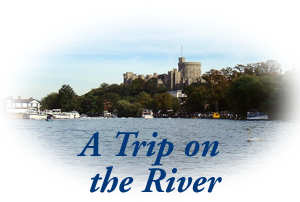 'Just messing about on the river' is one
of the most pleasant ways to while away an hour or two on a warm
sunny day. From Windsor promenade there are a number of self-drive
motorboats and rowing boats for hire in order to do just that.
For those requiring just a little more luxury, and a little less
effort, pleasure launches leave regularly for a delightful trip
to Boveney Lock and back, lasting about 35 minutes. Longer trips
are also available as well as the opportunity to hire a launch
for your own private party. 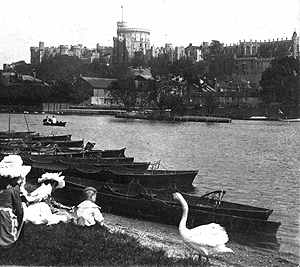 These days the boats for hire are sturdy dinghies with outboard motors, easily steered by a wheel in the front of the boat, together with a simple combined forward and reverse gear lever, that also controls the speed. 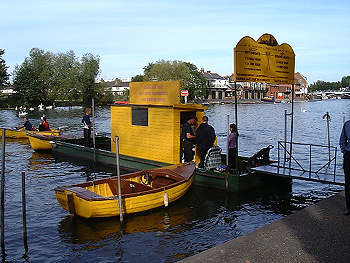 There are only a couple of 'rules of the river'. The first is to drive on the right, the second is to steer slowly and gently, anticipating course changes and allowing a few moments for the boat to respond, the third is to keep out of backwaters where you may get stuck, and the fourth is to keep an eye open for fishermen and their floats, moving away from the bank to avoid snagging their lines. You can be confident that the main stream, the river itself, holds no hidden dangers provided that you keep a reasonable distance from the banks. 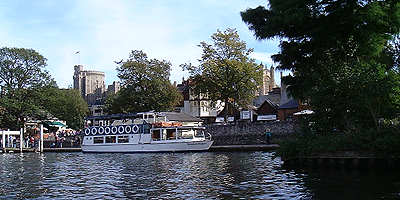 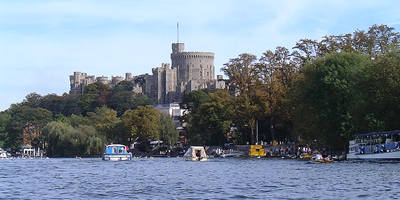 For the first part of the river trip you may like to go downstream as far as Windsor Bridge. The bridge was built between 1822-24 and The Royal Windsor Web Site features the history of the bridge here. In 2002 HM Queen Elizabeth re-opened Windsor Bridge following repairs to the cast-iron supports which had forced its closure to road traffic in the 1970s. The bridge was completely renovated with a new York stone footway and a new colour scheme and lighting, the work designed to co-incide with The Golden Jubilee. 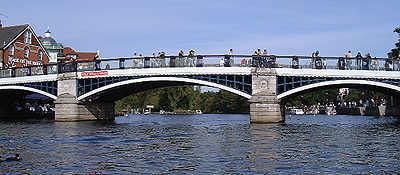 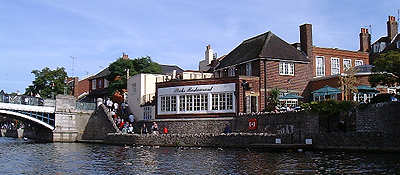 On the Windsor bank by Windsor Bridge is
the hotel formerly known as Sir Christopher Wren's House Hotel
although no connection with Wren has been proved. 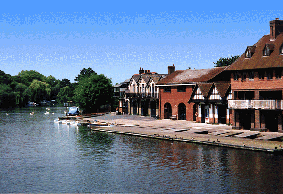 Beyond the boathouses on the right is 'The
Brocas', an open area of land in the care of Eton College. The
Brocas family were land owners in Gascony, Aquitaine (in France)
almost 1000 years ago and supported Edward I when Aquitaine passed
to England in 1152. In the early 1300s John (de) Brocas had come
to Windsor through his close connections with the royal court,
married an English woman, Margaret, and was enjoying rights granted
by the king to land around the town, including Etonmede (The
Brocas) in 1330 also becoming Lord of the Manor of Clewer and
Chief Forester of Windsor Forest. John Brocas also had interests
in the wine trade and it is believed that there was a vineyard
at Clewer. At St Andrew's Church, Clewer, there is the Brocas
Chapel. Today much of the land on the north side of the river
belongs to Eton College which can be seen across the meadows. 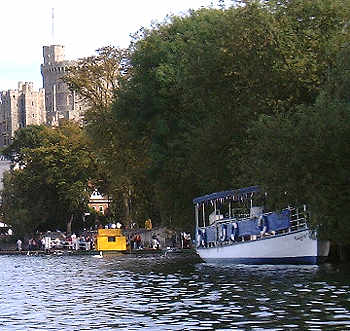 For many years Jacobs operated The Windsor Belle, The Empress
of India and the Windsor Castle,
three large and beautiful, Thames steamers in varnished wood,
from the Windsor promenade until The Empress and the Windsor Castle were
bought by Turks of Kingston. According to the National Register
of Historic Vessels, whose entries are included here in brackets,
the Empress of India
was built in 1898,
(Gross Tonnage: 53.00 Length Overall:
21.64 metres, Passenger Vessel. Bibliography, Hamer, Geoffrey,
1995, Trip Out 1995/6 - A Guide to the Passenger Boat Services
of the British Isles, pp. 22, G P Hamer. Also Hamer, Geoffrey,
1996, Trip Out 1995/6 - A Guide to the Passenger Boat Services
of the British Isles Supplement, G P Hamer), the Windsor
Belle in 1901 (Edward
Burgoine, at A Jacobs, Windsor, Saloon Launch)
and the Windsor Castle in 1923. (New Windsor
Castle, Arthur Jacobs, Windsor, Passenger Vessel). All are believed to have been built
on Jacob's Island. The Empress and the Windsor Castle
are now laid up at Sunbury [as of 2002], due to strict European
regulations concerning the carriage of passengers. The blue and
white Gaiety seen here moored on Jacob's Island is a most beautiful
steel hulled, twin screw, Thames steamer dating from 1887. Now
diesel powered, Gaiety remains in regular service although the original
aft saloon has been removed. She was originally named Oxford and operated initially on the Thames by Salters
Steamers. In those days, river travel, scheduled passenger services
throughout the length of the Thames, were very common but nowadays
are very limited. From 1927 Gaiety (as Oxford)
worked the Severn Estuary and The Kennet and Avon Canal before
being brought back to the Thames at Runnymede, partly by road,
by her new owners, the boat operators French Brothers, in 1987.  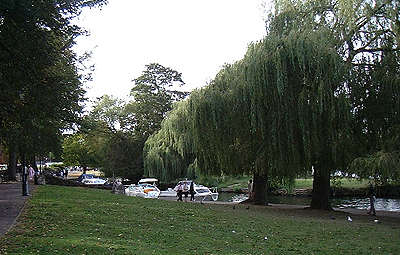 The backwater around Baths Island is next
on the Windsor bank, though it is not recommended that you take
your hired motor boat down here as navigation is restricted.
We suggest you use your time to proceed further upstream, passing
Deadwater Ait and Baths Island to the left. Although now one
island, the two were originally separated by a channel between
them. Baths Island is so named as it was indeed the town's swimming
baths noted on maps as early as the 1860s. Subsequently the banks
were concrete lined, the islands joined and hand rails fitted
along the waterline, probably in the 1930s and changing rooms
erected adjacent to the railway arches. 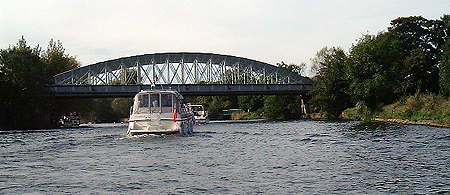
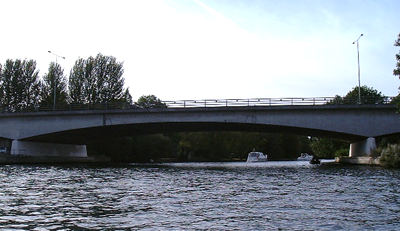 Further upstream is the road bridge, The
Elizabeth Bridge dating from the mid 1960s, and built just in
time before Windsor Town Bridge had to be closed to traffic. 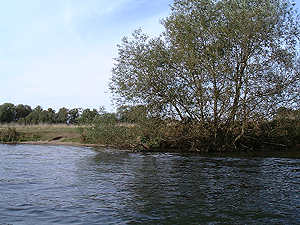 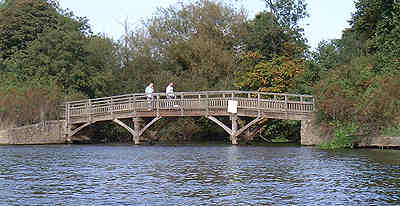 Continuing upstream is Boveney Lock and Weir, with Windsor Racecourse stretching out on the south side of the river. By now you are probably approaching half way through your paid time, so enjoy the countryside and slowly make your way back to Windsor. We sincerely hope you have a very pleasant trip.
|